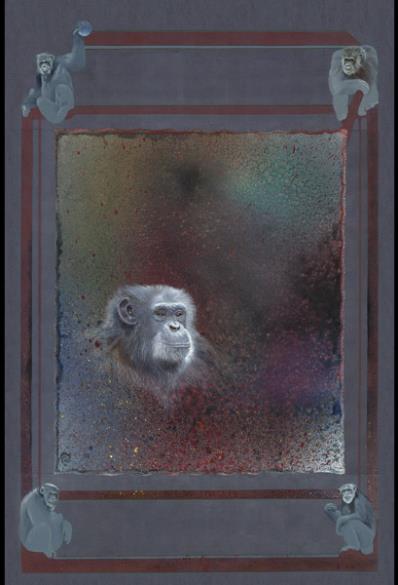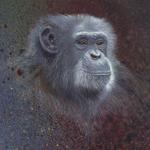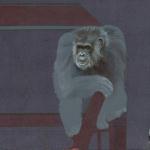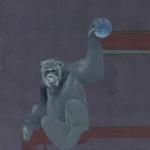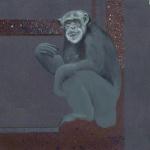With only 100,000 to 200,000 chimpanzees remaining in the wild and about 250 in zoos in the United States, chimpanzees are the most endangered primates in Africa.
Chimps are social creatures with complex behaviors and highly developed social relationships. They live in communities of 20 to 150 individuals and hunt in groups led by an alpha male. At home in trees and on the ground, chimps sleep in trees where they build nests of branches and leaves. They skillfully use tools and have been observed feeding on medicinal plants when they are sick or injured.
Chimpanzees have experienced a significant population decline over the past 30 years, a trend which is expected to continue due to deforestation, habitat loss and degradation, mining, agricultural development, increasing human population, poverty, human disease, invasive alien species, and climate change threaten the chimpanzee’s natural habitat.
 | ||||
RAMA: AMBASSADOR FOR THE ENDANGERED ONES
Speaking Passionately on Behalf of Those who Cannot Speak
EVERYTHING WE DO MATTERS
by Calley O’Neill and Rama the Elephant with Jeb Barsh
Chimpanzee (Pan troglodytes)
An International Traveling Exhibition
by Calley O'Neill and the Rama Team, Featuring Rama, the Artist Elephant
A JOURNEY OF ART AND SOUL FOR THE EARTH
STATUS: Year assessed – 2007 Endangered, CITES (Convention on International Trade) Appendix I (may be threatened with extinction) Included in the American Species Survival Plan. Chimpanzees have had significant declines in population over the past 20 to 30 years and are expected to continue declining due to high levels of exploitation, loss of habitat and habitat quality due to expanding human activities and the illegal bushmeat trade.
According to the National Primate Research Center there are potential solutions for each of these factors, a few examples follow:
- Research
- Sustainable forest practices, which can actually improve the chimpanzee population by decreasing mechanical logging equipment and disturbance. Successional forest plantings can provide a higher abundance of fruits to eat
- Enforcing rigorous codes of conduct for logging companies
- Limiting human proximity to the chimps to reduce the likelihood of the spread of human disease
- Creating alternative food sources and sustainable use policies for forest resources in African countries
- More sanctuaries and protected wildlife parks must be created
This painting features the beloved chimpanzee, Charlie, ‘Prince of the Zoo’, who lived and thrived at the Oregon Zoo with four females from 1972 until 2009. Charlie stood 5’ tall and packed 160 pounds of solid muscle equal to the strength of five strong men. Female chimps are somewhat smaller. Charlie was sensitive and powerful, territorial and thoughtful, a peacemaker and a chief. Together with his senior keeper and close companion, Dave Thomas and a family of keepers and volunteers who loved him dearly, he lived at the zoo for 35 years. Saved from the bushmeat trade, Charlie went on to touch the lives of millions of people and animals. Our closest living relative, sharing over 98% of our DNA, Charlie seemed so human that he never failed to amaze and inspire his visitors.
According to the Oregon Zoo, Charlie was born in the forest along the Liberia and Republic of Sierra Leone border in West Africa around 1970. One day, Edward Miller, an American mining contractor saw villagers walking around town with a baby chimp. Aware of the prevalent bushmeat trade, Miller realized that the chimp’s mother had almost certainly been killed and the infant was likely bound for the cooking pot as bushmeat. Immediately, Miller offered to buy the chimp, no questions asked, and named him after the mining camp's radio call letters. Charlie returned to the United States to live with Miller and his three young sons before outgrowing their ability to care for him. The family gave Charlie to the Washington Park Zoo about a year later. He moved in with four females, Delilah, Leah and their mother Coco, who at 57 is the zoo’s oldest resident, and Chloe, a former circus performer.
The zoo made the Miller family and Charlie a promise - a promise that has been kept and extended to the other zoo residents and zoo animals around the world. Starting with Charlie, the keepers began to develop an enrichment program. At the outset, the program focused on human/animal interaction, including American Sign Language; play, training and contact with animals.
After years of experimentation, enrichment strategies shifted away from human interaction in order to preserve the animals’ wild nature. Now, enrichment encourages natural behaviors through training, exercise and toys. Enrichment gives choice, change and control to the animals. By engaging all their senses, the animals receive mental and physical stimulation. Although the focus of enrichment continually evolves, it all began with Charlie at the Oregon Zoo, initiating the careers of those people dedicated to developing enrichment programs.
"Chimps are an iconic species and among our closest relatives on this planet," said US Fish and Wildlife Service (FSW) director Dan Ashe (June 12, 2013) in a statement regarding the proposal to grant captive chimps the same endangered species as wild chimps. "We hope this will ignite renewed public interest in the plight of chimps in the wild."
The United States is the only developed country in the world that sanctions the use of chimpanzees for research. The National Institute of Health has 612 of the 937 captive chimpanzees available for research in the United States. The proposed change is a response to a 2010 petition by wildlife conservation groups including the Jane Goodall Institute and the Humane Society of the United States.
This painting is dedicated to the chimpanzees in the world and all their descendants, which they may live for all time. For all who protect chimps, and the pioneering elders such as Jane Goodall who fell in love with Charlie long ago ~ our gratitude and appreciation.
Long live the chimpanzees!
Michael Durham, Oregon Zoo photographer, took the reference photo.
Chimps are People Too
by Julia Fairchild
Did you know that they
- Use tools
- Fall in love
- Love beauty
- Understand and use sign language
- Like to be tickled
- Laugh
- Are kind to other animals
- Watch sunsets
- Use herbal remedies when sick or injured
- Mourn the loss of a loved one




